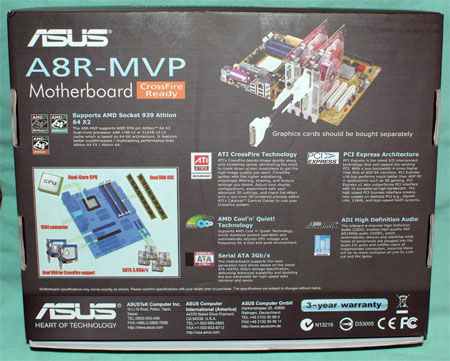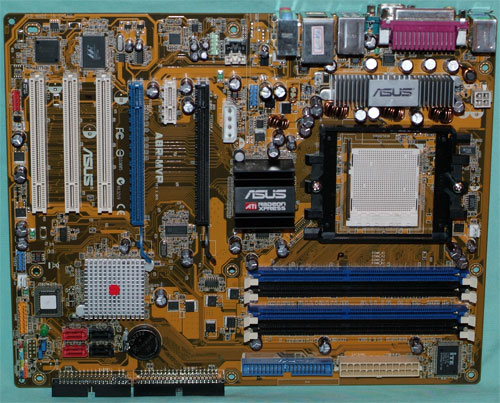
Original Link: https://www.anandtech.com/show/1871
Asus A8R-MVP: Mainstream Rocket
by Wesley Fink on November 23, 2005 1:15 AM EST- Posted in
- Motherboards
When the Asus A8R-MVP landed on our doorstep, we were frankly a bit disappointed. Here was the first Asus board built with the ATI Crossfire AMD chipset and the first board to market that uses the ULi M1575 south bridge instead. If you recall from our launch review of the M1575, this ULi south bridge fully supports SATA2 and provides competitive USB performance - removing the few nagging issues with the excellent ATI Crossfire AMD chipset.
So, why were we disappointed? We really hoped that Asus would deliver a super high-end board, much like the Asus A8N32-SLI deluxe 8-phase that we recently reviewed. That kind of board could clearly show what the Crossfire AMD chipset was really capable of doing. Instead, we had a competent-appearing mainstream board that will likely sell in the $100 to $125 price range. Our first thoughts, naturally, were "ho-hum", a solid but unspectacular Crossfire AMD.
We even talked with Asus about why they didn't lavish their attentions on the A8R-MVP, and we were given perfectly reasonable explanations. With Dual x16 NVIDIA now available, Asus really believed that the ATI Crossfire AMD was better positioned as a mainstream product, and Asus would likely give "top-end treatment" to the upcoming RD580 ATI Dual x16 Crossfire chipset for AMD. We couldn't argue with the Asus logic, but it did not stop our disappointment that maybe this board could have had it all for those looking for an ATI chipset solution for Athlon 64 Socket 939.
If we always went with our assumptions, there would be no reason at all to test motherboards, and thankfully, our first opinions are often proven wrong in the actual testing. As we began benchmarking the A8R-MVP, we realized that our assumptions were completely wrong and this board might prove to be the board many have been waiting for. It turns out that there is absolutely nothing missing from the feature set of the A8R-MVP except the high price, and we think that you will enjoy our journey with this board.
We also had a few shocks in other areas. Our first attempts at overclocking were pretty average, but as we persevered, we had another assumption shoved back in our face.
This isn't a mistake. This is a screen capture of the Asus A8R-MVP after running 2 days at 325x9 - the highest overclock that we have ever achieved with our standard OCZ PC3200 Platinum Rev.2 memory and our 4000+ CPU. We actually reached even higher overclocks, but 325 was completely stable with air cooling.
Now that you know that this average-priced motherboard turned out to be anything but average in performance, join us as we take a closer look at the motherboard that may turn out to be the value-priced rocket everyone is looking for.
Asus A8R-MVP: Board Layout
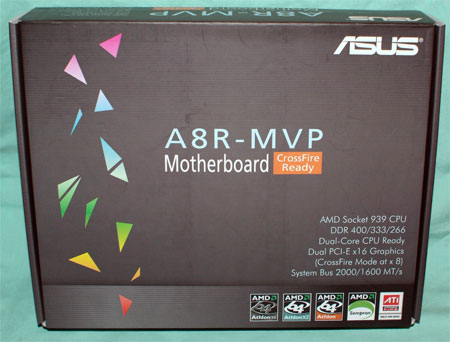
Nonetheless, all the top Crossfire AMD features are there, such as dual x16 PCIe slots that support a single x16 video card or dual x8 Crossfire.
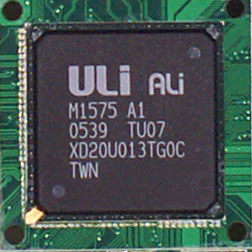
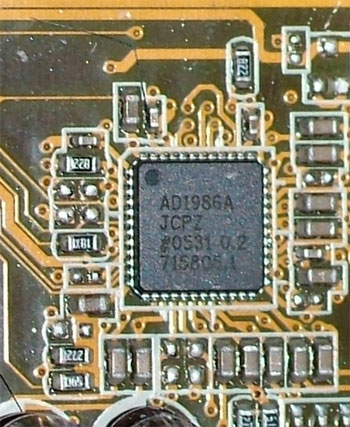

The basic layout of the A8R-MVP is typically Asus, meaning that the layout overall is very good. Cooling is passive - there are no active fans - which is also typical of Asus designs. You will notice that there is nothing on the board which would announce that this might be a serious overclocker, except perhaps for the large heatsink covering the power Mosfets. Even here, we see a 3-phase design instead of the robust 4-phase designs used on the ATI Reference boards.


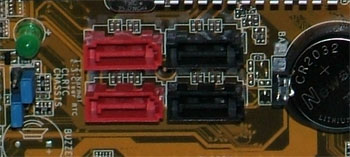


Basic Features: Asus A8R-MVP
| Asus A8R-MVP | |
| CPU Interface | Socket 939 Athlon 64 |
| Chipset | ATI RD480 Northbridge - ULi M1575 Southbridge |
| Bus Speeds | 200 to 400MHz in 1MHz Increments |
| Memory Speeds | DDR200, 266, 333, 400 (433, 466, 500 with Rev. E AMD) |
| PCIe Speeds | 100 to 150MHz in 1MHz Increments |
| PCI/AGP | Fixed at 33/66 |
| Core Voltage | Auto, 0.8V to 1.45V in 0.025V increments PLUS 0.2V with vCore Over-voltage (Maximum vCore 1.65V) |
| CPU Clock Multiplier | 4X-25.5X in 0.5X increments |
| DRAM Voltage | Auto, 2.65V to 3.2V in .05V to .1V increments |
| HyperTransport Frequency | 1000MHz (1GHz) |
| HyperTransport Multiplier | Auto, 1X to 5X |
| PCI Express Voltage | 1.2V, 1.3V, 1.4V, 1.5V |
| Southbridge Overvoltage | Enabled (+0.1v) |
| PEG Link Mode | Auto, Disabled, Normal, Fast, Faster |
| PEG Bugger Length | Auto, Short, Long, Longer, Longest |
| AI Overclocking | Manual, Auto*, Standard*, Overclock Profile *Set CPU Frequency and Other Parameters Automatically |
| Overclock Profile Options | 3%, 5%, 10%, 15%, 20%, 30% |
| Memory Slots | Four 184-pin DDR DIMM Slots Dual-Channel Configuration Regular Unbuffered or ECC Memory to 4GB Total |
| Expansion Slots | 2 PCIe x16 1 PCIe x1 3 PCI Slots 1 Asus MVP Switch Card in Secondary (Black) PCIe Slot |
| Onboard SATA/RAID | 4 SATA2 Drives by ULi M1575 (RAID 0, 1, 1+0, 5, JBOD) |
| Onboard IDE/IDE RAID | Two Standard ATA133/100/66 (4 drives) |
| Onboard USB 2.0/IEEE-1394 | 8 USB 2.0 ports supported by ULi M1575 2 1394 Firewire by TI 1394 |
| Onboard LAN | 1 Gigabit Ethernet PCI Ethernet by Marvel Yukon 88E8001 |
| Onboard Audio | Azalia HD Audio by ADI AD1986A Soundmax codec |
| BIOS Revision | AMI 0037 (11/17/05) Beta |
While the BIOS adjustments are not as extensive as the Asus A8N32-SLI Deluxe or the DFI RDX200, most of the adjustments needed for overclocking control are definitely here.
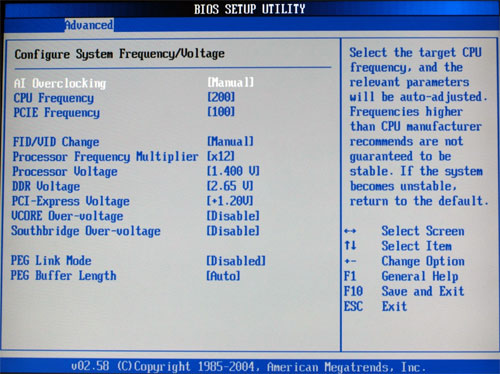
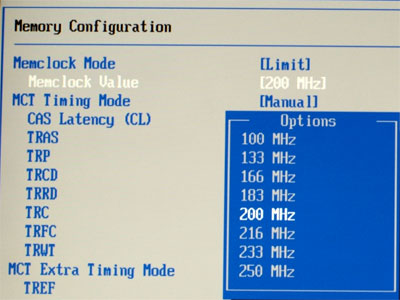

Overclocking
| Asus A8R-MVP Overclocking Testbed | |
| Processor: | Athlon 64 4000+ (2.4GHz, 1MB Cache) |
| CPU Voltage: | 1.45V (default 1.40V) |
| Cooling: | Thermaltake Silent Boost K8 Heatsink/Fan |
| Power Supply: | OCZ Power Stream 520W |
| Memory: | OCZ PC3200* Platinum Rev. 2 (Samsung TCCD Memory Chips) *The current equivalent OCZ memory is OCZ PC4800 |
| Hard Drive: | Seagate 120GB 7200RPM SATA 8MB Cache |
| Maximum OC: (Standard Ratio) |
246x12 (4x HT, 2.5-3-3-7) 2952MHz (+23%) |
| Maximum FSB: (Lower Ratio) |
325 x 9 (3x HT, 2T*, 3-4-3-8) (2925MHz, 2 DIMMs in DC mode) (+62.5% Bus Overclock) |
Screen captures on the first page have already announced that the Asus A8R-MVP has set new overclocking records in our testing. We actually found 330 to be stable in memtest86 and booted into Windows at a little more than 330 with memory set to a DDR400 starting point. However, Windows was not completely stable at 330 and required a slight lowering to 325 (DDR650). The 325 setting was completely stable, ran our benchmarks, and ran for more than 2 days on just air cooling.
Our first efforts at overclocking the A8R-MVP ran into a road block at just over 260. We have found some Asus boards in the past that did not like overclocks to be immediately set to high values, so we started again at 250. By going up just 5 to 10FSB at a time, we were able to reach 325. Since we had no idea that we would reach such a high OC on this mainstream board, we have screen captures at every 5MHz from about 270 to 330. Our advice to overclockers on this board is to move the overclock up slowly.
*UPDATE: After further testing we have concluded that the A8R-MVP handles 1T timings only to about 260-265. Above 260-265 you will need 2T timings to reach 325 or so clock frequency. We ran into a wall at 260 and apparently the BIOS reset. The default is 2T and we didn't catch the Command Rate reset. This board uses very aggressive timings, and the 2T memory bandwidth was so fast we did not realize the board was actually running at 2T. This does not change the fact that 325 at 2T is an outstanding overclock, but it is achieved at 2T timings, and not at 1T as originally reported.
Those who don't understand overclocking or who don't want to bother will find extensive automatic overclocking options in the Asus BIOS. This allows you to set an overclock and have the board adjust the related settings. These work well for modest overclocking, but they will not allow the extreme results achieved manually on the Asus A8R-MVP.
Memory Stress Testing
The Asus A8R-MVP easily handles 2-2-2-7-1T timings at stock speed, as do almost any of the current boards for AMD Socket 939 from NVIDIA, SiS, VIA, ATI, and ULi. However, the default setting for Command Rate in the Asus BIOS is 2T, and you need to manually set Command Rate to 1T for best performance with 2 DIMMs in Dual Channel mode. Asus tells us that this was done to accommodate some memory manufacturers that had asked for a default 2T Command Rate for maximum compatibility with their memory. Once set, we had no issues using 1T command Rate with any memory that we tested.
Running four double-sided 512MB or 1GB DIMMs is much more demanding than running two DS DIMMs, and Asus did not have any extra magic here. Like every board that we have tested except the DFI RDX200, we needed to drop the Command Rate to 2T with 4 DS DIMMs. With 4 DIMMs, the A8R-MVP remained stable with the same aggressive 2-2-2-7 timings used for two DS DIMMs.
| Stable DDR400 Timings - 4 DIMMs (4/4 DIMMs populated) |
|
| Clock Speed: | 200MHz |
| CAS Latency: | 2.0 |
| RAS to CAS Delay: | 2T |
| RAS Precharge: | 7T* |
| Precharge Delay: | 2T |
| Command Rate: | 2T |
Test Setup
| Performance Test Configuration | |
| Processor(s): | AMD Athlon 64 4000+ (2.4GHz) Socket 939 |
| RAM: | 2 x 512MB OCZ PC3200* Platinum Rev. 2 *The current equivalent OCZ memory is OCZ PC4800 |
| Hard Drive(s): | Seagate 120GB 7200 RPM SATA (8MB Buffer) |
| Video Cards: | MSI NVIDIA 7800GTX MSI RX1800 |
| Video Drivers: | NVIDIA Forceware 81.85 Release ATI Catalyst 5.11 Release |
| Operating System(s): | Windows XP Professional SP2 Direct X 9.0c |
| Motherboards: | Asus A8R-MVP (ATI RD480/ULi1575) Asus A8N32-SLI Deluxe DFI LANParty UT RDX200 (ATI RD480) ATI Crossfire AMD Reference Board SiS 756 Reference Board ASRock 939Dual-SATA2 (ULi M1695/1567) Sapphire A9RX480 (ATI) Jetway 939GT4-SLI-G (nForce4) ULi AP9567A (M1695/M1567) DFI LANParty nF4 SLI-DR (nForce4) DFI LANParty UT nF4 Ultra-D (nForce4) MSI K8N Neo4/SLI Platinum (nForce4) |
Tests used OCZ PC3200 Platinum Rev. 2, which uses Samsung TCCD chips. All memory ran at 2-2-2-7 timing in all benchmarks.
We tested with the NVIDIA 7800GTX using nVidia 81.85 drivers to provide the most up-to-date performance results. We also ran graphics and games benchmarks with the MSI RX1800 (X1800XT) using Catalyst 5.11 drivers. Resolution in all benchmarks is 1280x1024x32 unless otherwise noted. 3DMark and Aquamark3 benchmarks use "Standard Score" setup, which is 1024x768 video resolution.
Results for the Asus A8R-MVP are in red. Test results for other motherboards are in blue.
General Performance
There is little to distinguish or detract from the Asus A8R-MVP in Winstone benchmarks. The Asus board is competitive with the best Socket 939 Athlon 64 boards that we have tested. We have already established that the ATI chipset competes well with other AMD chipsets. Performance in Winstones falls in the center of tightly clustered performance.
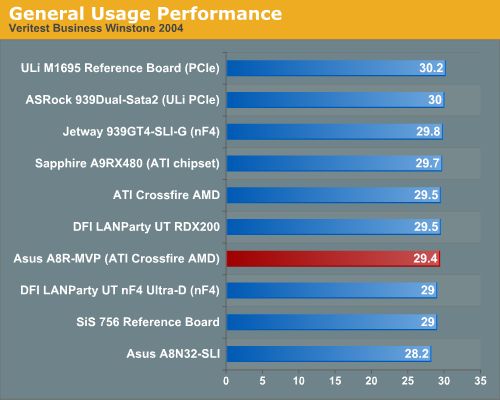
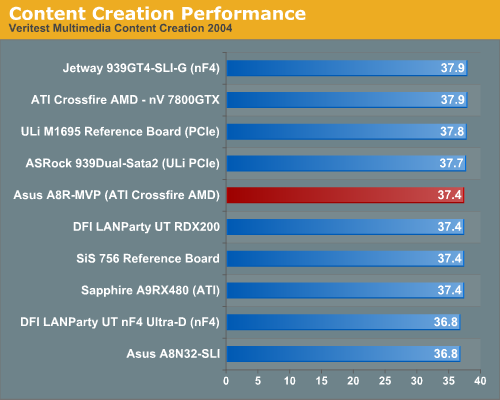
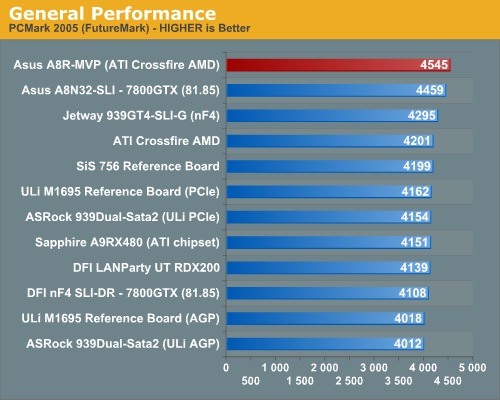
Graphics Performance and Encoding
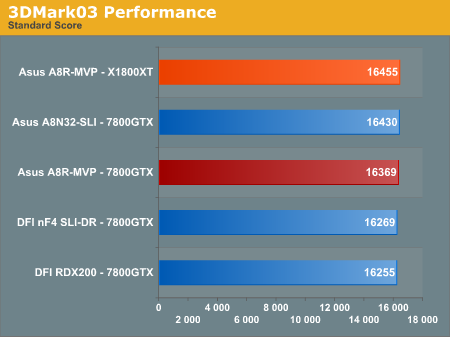
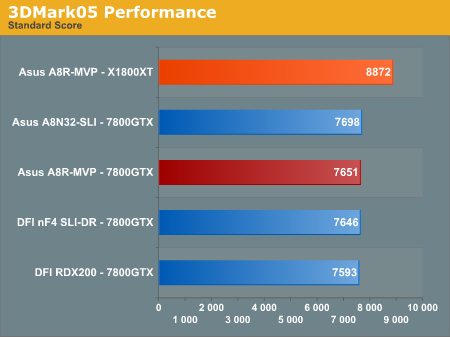
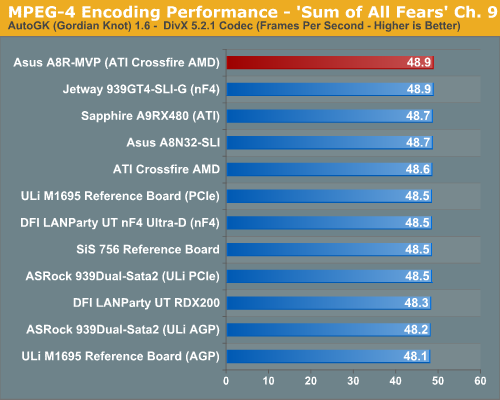
It is interesting that the ATI X1800XT wins all synthetic benchmarks using the latest 5.11 Catalyst drivers. The 5.11 drivers do make the X1800XT behave like a different vidoe card.
Encoding results should not be affected by the graphics card used during the encoding benchmarks. This is clearly demonstrated by the archive test results for AutoGK using an AMD 4000+ processor with a wide assortment of other components. The performance range of those encoding tests is just 48.1 to 49.9 - a difference form high to low of just 0.8 frames. Clearly, the biggest influence on this encoding benchmark is the CPU used for testing.
Gaming Performance
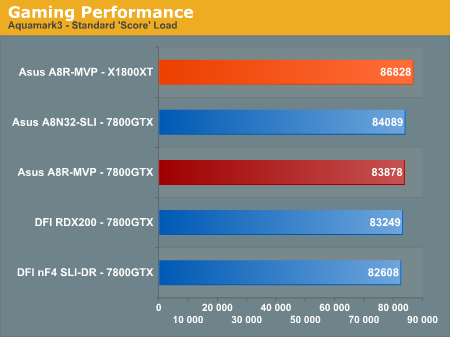
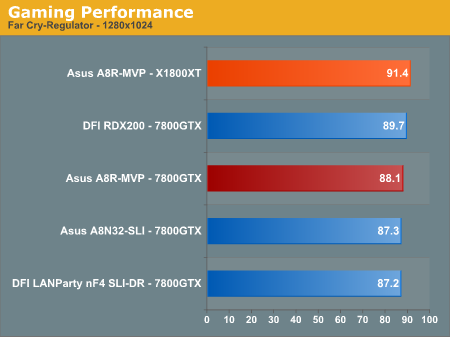
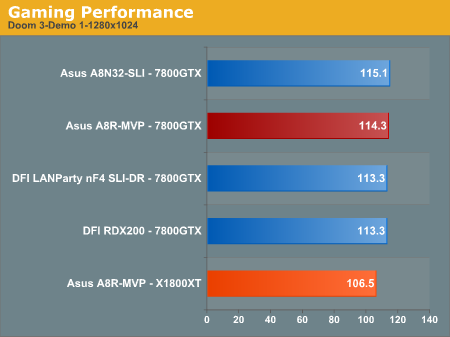
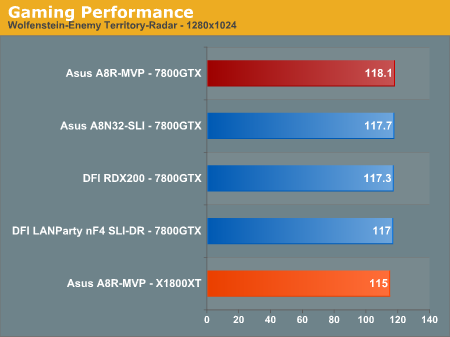
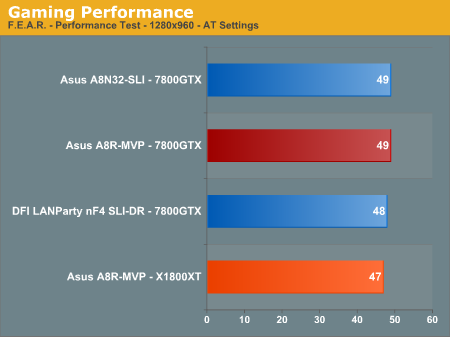
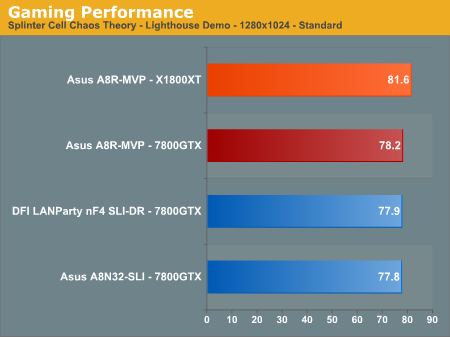
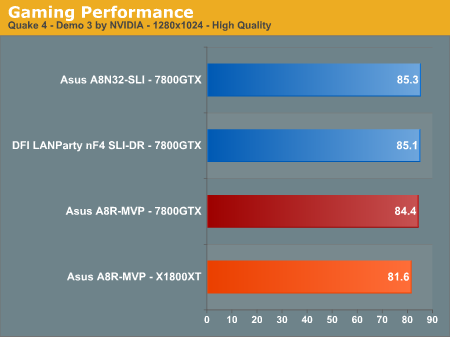
We also ran benchmarks with three new games: Quake 4, Splinter Cell - Chaos Theory, and F.E.A.R. The Asus A8R-MVP was at or near the top in every game test, both our standard suite and the newest game tests. This was frankly a bit surprising, since we just recently found top gaming performance with the Asus A8N32-SLI, based on the new NVIDIA Dual x16 chipset.
Results with the ATI X1800XT on the Asus A8R-MVP were very intersting. THe X1800XT was either tops or matched results in all games not based on Open GL engines. In games base on Open GL, like Quake 4 and Doom 3, the new 5.11 driver has made up most, by not quite all, of the performance advantage perviously held by the nVidia 7800GTX. Keep in mind that these results are our standard tests, with AA and AF turned off if possible. We have found that as soon as AA and AF are turned on the X1800XT is tops even in Open GL compared to the 7800GTX.
Overclocking Comparisons
Maximum overclock data was added to our Performance graphs beginning with the nForce4 SLI roundup earlier this year. The overclocking performance graphs allow a better comparison of the overclocking capabilities of tested boards. For more details on the specific overclocking abilities of a specific board, please refer to the Overclocking and Memory Stress Test section of individual board reviews.
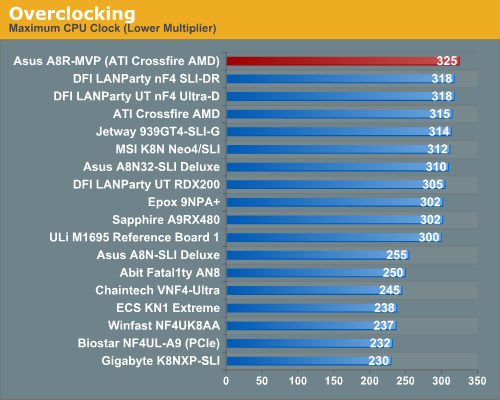
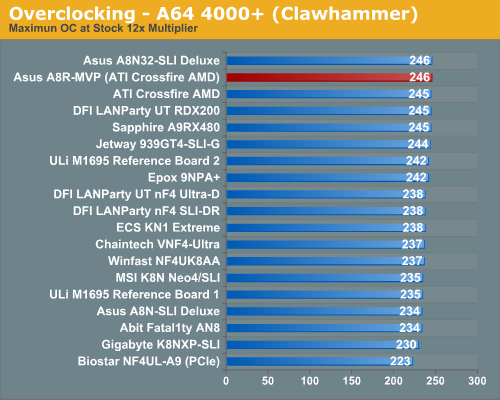
No one, least of all this reviewer, expected this kind of overclocking with this mainstream Asus board. Once in a while, you run across a mainstream or value board that surprises you with its capabilities. This board is one of those surprises. Frankly, the Asus A8R-MVP may be the best thing to happen to ATI's new Crossfire chipsets.
ATI has made tremendous progress in board design since we looked at the initial Bullhead board last November. Asus definitely went their own way in the design of the A8R-MVP, but the simplicity of the board more than likely contributes to the great overclocking that we experienced.
It is very important that users change the default 2T Command Rate to 1T for best performance. Asus ships the A8R-MVP with 2T enabled to satisfy some memory manufacturers. The board has no trouble running 1T with quality memory, but you have to set the 1T Command Rate manually. All overclocking was performed with the Command Rate at 1T and the Command Rate was verified in AMD Tweaker.
USB Performance
USB has been a problem area for the ATI SB450 chipset, so we were anxious to test the ULi M1575 South Bridge, which is supposed to fix USB performance issues. We ran our standard USB throughput test on the Asus A8R-MVP using an external USB hard drive.
Our test method uses a RAM disk as our “server”, since memory removes almost all overhead from the serving end. We also disable disk caching on the USB and Firewire side by setting up the drives for “quick disconnect”. Our results are then consistent over many test runs.
We use just 1GB of fast 2-2-2 system memory, set up as a 450MB RAM disk and 550MB of system memory. Our stock file is the SPECviewPerf 8.01 install file. which is 432,533,504 bytes (412.4961MB). After copying this file to our RAM disk, we measure the time for writing from the RAM disk to our external USB 2.0 or Firewire 400 or Firewire 800 drive using a Windows timing program written for AnandTech by our own Jason Clark. The copy times in seconds are then converted into Megabits per second (Mb) to provide a convenient means of comparing throughput. Higher Rates therefore mean better performance.
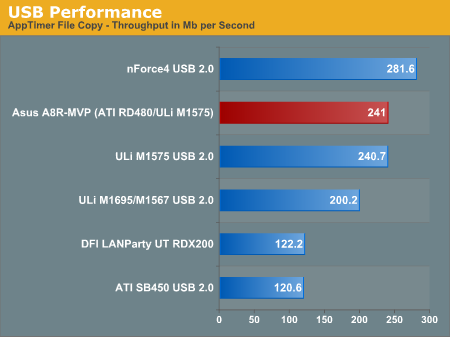
In addition to competitive USB performance, the M1575 also provides the SATA2 ports that are missing from the ATI SB450. The ULi SATA2 also supports RAID 0, 1, 0+1, 5, and JBOD.
Disk Controller Performance
With the variety of disk drive benchmarks available, we needed a means of comparing the true performance of the wide selection of controllers. The logical choice was Anand's storage benchmark first described in “Q2 2004 Desktop Hard Drive Comparison: WD Raptor vs. the World”. To refresh your memory, the iPeak test was designed to measure "pure" hard disk performance, and in this case, we kept the hard drive as consistent as possible while varying the hard drive controller. The idea is to measure the performance of a hard drive controller with a consistent hard drive.
We played back Anand's raw files that recorded I/O operations when running a real world benchmark - the entire Winstone 2004 suite. Intel's iPEAK utility was then used to play back the trace file of all IO operations that took place during a single run of Business Winstone 2004 and MCC Winstone 2004. The drive was formatted before each test run and a composite average of 5 tests on each controller interface was tabulated in order to ensure consistency in the benchmark.
iPeak gives a mean service time in milliseconds; in other words, the average time that each drive took to fulfill each IO operation. In order to make the data more understandable, we report the scores as an average number of IO operations per second so that higher scores translate into better performance. This number is meaningless as far as hard disk performance is concerned as it is just the number of IO operations completed in a second. However, the scores are useful for comparing "pure" performance of the storage controllers in this case.
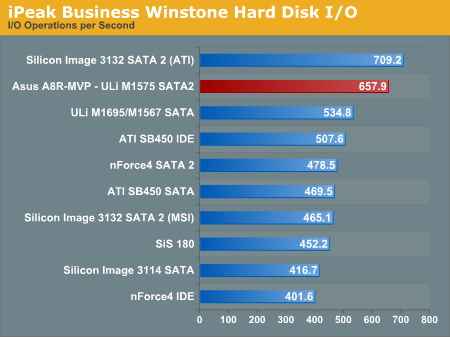
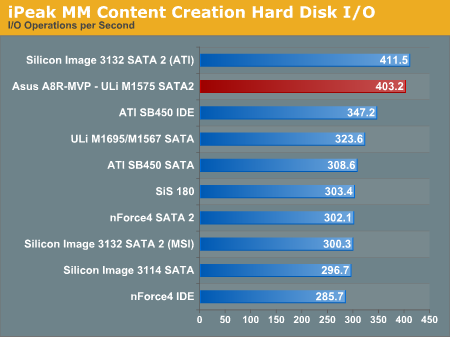
Audio Performance
For audio testing, we used Rightmark 3D Sound CPU utilization test, which is the same benchmark run in our earlier nForce4 SLI and Ultra roundups. This benchmark measures the overhead or CPU utilization required by a codec or hardware audio chip. We tested performance using the latest version 2.1. Since we found that Version 2.1 yields different results from the earlier 1.24, we have only included test results with version 2.1.
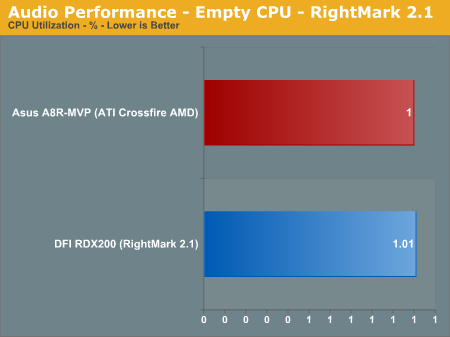
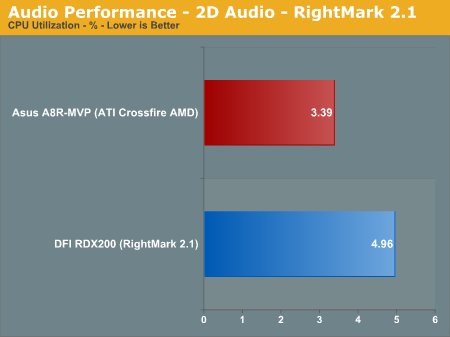
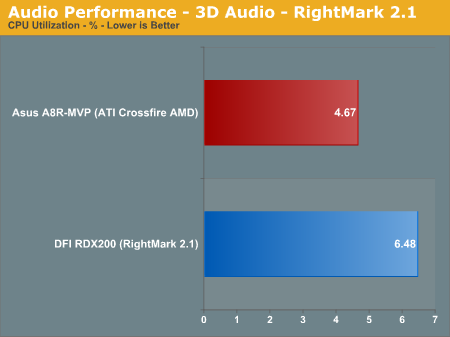
It is very important to point out that the ATI chipset motherboards have the necessary hooks to deliver Azalia High Definition audio. Those who have been complaining about the poor AC'97 audio present on most AMD boards should be very pleased to find Azalia HD on the ATI chipset boards. The nForce4 family does not offer the necessary chipset hooks to support HD Azalia audio.
Ethernet Performance
The one area where the Asus A8R-MVP is mildly disappointing is in their choice of an Ethernet controller. Instead of using a PCIe LAN that is capable of providing full 1 Gb bandwidth, Asus used a PCI solution that will be limited in maximum speed by the PCI bus. In practical terms, the PCI bus caps out about 700 Mb/s compared to the 950Mb/s capability of a 1 Gigabit PCIe solution. Since most broadband Ethernet connections barely tax 10Mb/s, this really only matters to those who do sustained high-speed transfer of very large files over a true 1Gb network - probably less than 1% of users. Still, you should be aware that PCIe Gigabit Ethernet is always a better solution.
The Windows 2000 Driver Development Kit (DDK) includes a useful LAN testing utility called NTttcp. We used the NTttcp tool to test Ethernet throughput and the CPU utilization of the various Ethernet Controllers used on the AMD motherboards.
We set up one machine as the server; in this case, an Intel box with an Intel CSA Gigabit LAN connection. Intel CSA has a reputation for providing fast throughput and this seemed to be a reasonable choice to serve our Gigabit LAN clients. At the server side, we used the following Command Line as suggested by the VIA whitepaper on LAN testing:
Ntttcps -m 4,0,‹client IP› -a 4 -l 256000 -n 30000On the client side (the motherboard under test), we used the following Command Line:
Ntttcpr -m 4,0,‹server IP› -a 4 -l 256000 -n 30000At the conclusion of the test, we captured the throughput and CPU utilization figures from the client screen.

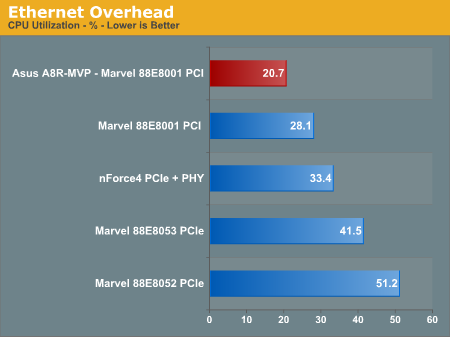
Final Words
Users were more disturbed than ATI may have thought with the limitations of the SB450 south bridge. In practical terms, it made no real difference at all in performance, since SATA2 is not really faster than SATA1 with current drives, and most USB transfers don't come even fractionally close to taxing the transfer capabilities of USB 2.0. However, for most users, competitive USB and SATA2 are options that don't need their performance to be explained - they are check list items that should perform exactly as users expect - not items with sub-par performance or missing from the check list.
The Asus A8R-MVP is the first motherboard that we have tested to use the ULi M1575 instead. The M1575 does provide competitive USB 2.0 performance and the SATA2 ports that are missing on the ATI SB450. We will also see the ULi M1575 on the MSI and Abit ATI chipset motherboards, as well as others coming down the pike. The performance of the ULi M1575 proves that Asus and others made a good choice in this south bridge.
The most important thing that the Asus A8R-MVP brings us, however, is not the competitive USB and SATA2 capabilities - they are just icing on the cake. The A8R-MVP is a monster of an overclocker - a mainstream board that proves that you don't have to spend a fortune to get incredible flexibility in pushing your system performance to new levels. This is the kind of board that serious overclockers love - a value-priced board that can be coupled to a value-priced AMD Socket 939 Opteron, for example, to get beyond top-of-the-line performance.
UPDATE: After further testing on shipping retail boards, we have concluded that a 2T Command Rate is needed for Clock frequencies above 260-265. We did not realize that the board we initially tested was actually reset to 2T in our benchmark tests at 325. However, the Asus A8R-MVP at 2T is often as fast as other board at 1T since the memory timings on this board are very agressive. The good news is that 320+ was in reach at 2T using good TCCD memory on all of the shipping retail boards we tested, and the performance at 2T was very competetive with other boards at the same speed at 1T Command Rate.
Asus tells us the Engineer responsible for this board design is a young professional, well-regarded for his creativity and promising design skills. Perhaps this is the first of many such surprises from this young Engineer.
In the end, the Asus A8R-MVP is definitely not what we expected. It is not top-end, expensive, 8-phase, or designed for the top overclock that anyone will ever achieve. It is really much more than any of those expectations. The A8R-MVP is a reasonably-priced, full-featured board that is not really missing any important features. Instead of the limitations of SB450, it has the advantages of ULi M1575. And this value-priced board produced the highest overclocks that we have ever seen with our OCZ Rev.2 Platinum memory and our 4000+ CPU.
As we said, it's a good thing that we actually test motherboards instead of relying on first impressions. The Asus A8R-MVP is exactly what many of you are looking for, and it is probably the best thing that could happen to the ATI AMD chipsets. A reasonably priced board that has all the check marks, is very fast at stock, and can overclock like a banshee is always a good thing.


